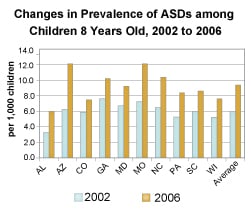And to all of you who have given us so much support since Aidan's diagnosis, thank you!
Prevalence
- It is estimated that between 1 in 80 and 1 in 240 with an average of 1 in 110 children in the United States have an ASD.
- ASDs are reported to occur in all racial, ethnic, and socioeconomic groups, yet are on average 4 to 5 times more likely to occur in boys than in girls. However, we need more information on some less studied populations and regions around the world.
- If 4 million children are born in the United States every year, approximately 36,500 children will eventually be diagnosed with an ASD. Assuming the prevalence rate has been constant over the past two decades, we can estimate that about 730,000 individuals between the ages of 0 to 21 have an ASD.
- Studies in Asia, Europe and North America have identified individuals with an ASD with an approximate prevalence of 0.6% to over 1%.
- Approximately 13% of children have a developmental disability, ranging from mild disabilities such as speech and language impairments to serious developmental disabilities, such as intellectual disabilities, cerebral palsy, and autism.
Economic Costs
- Recent studies have estimated that the lifetime cost to care for an individual with an ASD is $3.2 million.
- Individuals with an ASD had average medical expenditures that exceeded those without an ASD by $4,110–$6,200 per year. On average, medical expenditures for individuals with an ASD were 4.1–6.2 times greater than for those without an ASD. Differences in median expenditures ranged from $2,240 to $3,360 per year with median expenditures 8.4–9.5 times greater.
Signs of Autism (there were a lot of "a-ha!" moments the first time I read these after Aidan was diagnosed)
Most parents of autistic children suspect that something is wrong by the time the child is 18 months old and seek help by the time the child is age 2. Children with autism typically have difficulties in:
People with autism may:
Communication problems may include:
- Pretend play
- Social interactions
- Verbal and nonverbal communication
People with autism may:
- Be overly sensitive in sight, hearing, touch, smell, or taste (for example, they may refuse to wear "itchy" clothes and become distressed if they are forced to wear the clothes)
- Have unusual distress when routines are changed
- Perform repeated body movements
- Show unusual attachments to objects
Communication problems may include:
- Cannot start or maintain a social conversation
- Communicates with gestures instead of words
- Develops language slowly or not at all
- Does not adjust gaze to look at objects that others are looking at
- Does not refer to self correctly (for example, says "you want water" when the child means "I want water")
- Does not point to direct others' attention to objects (occurs in the first 14 months of life)
- Repeats words or memorized passages, such as commercials
- Uses nonsense rhyming
- Does not make friends
- Does not play interactive games
- Is withdrawn
- May not respond to eye contact or smiles, or may avoid eye contact
- May treat others as if they are objects
- Prefers to spend time alone, rather than with others
- Shows a lack of empathy
- Does not startle at loud noises
- Has heightened or low senses of sight, hearing, touch, smell, or taste
- May find normal noises painful and hold hands over ears
- May withdraw from physical contact because it is overstimulating or overwhelming
- Rubs surfaces, mouths or licks objects
- Seems to have a heightened or low response to pain
- Doesn't imitate the actions of others
- Prefers solitary or ritualistic play
- Shows little pretend or imaginative play
- "Acts up" with intense tantrums
- Gets stuck on a single topic or task (perseveration)
- Has a short attention span
- Has very narrow interests
- Is overactive or very passive
- Shows aggression to others or self
- Shows a strong need for sameness
- Uses repetitive body movements

No comments:
Post a Comment